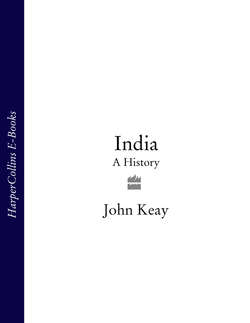Читать книгу India: A History - John Keay - Страница 21
WHERE WEST MEETS EAST
ОглавлениеOn the frontier of the Achaemenids’ Indian satrapy lay the city of Taxila (Takashila). Some thirty kilometres from what is now Pakistan’s capital of Islamabad, it was not agriculturally disadvantaged, although in the absence of major irrigation schemes the Panjab was scarcely the land of wheat, sugarcane and canals which it is today. Indeed, Taxila seems to have owed its early urbanisation more to its economically strategic location. Here, by way of rugged trails like that of the Khyber from Afghanistan, passed all trade – horses, gold, precious stones and luxury textiles – between the Achaemenid world and the emerging Gangetic states. The city prospered as did the satrapy. According to Herodotus, the latter yielded to the Achaemenids a tribute of ‘ant-gold’ which was nearly five times more than the tribute extracted from Babylon and seven times that from Egypt.
Such wealth attracted to Taxila artisans and scholars as well as merchants. Sir John Marshall, who excavated the site in the 1940s, found three cities, the oldest of which lay beneath the Bhir Mound. There rubble walls indicated several levels of occupation, beginning with one which certainly belonged to the Iron Age and probably to ‘the close of the sixth century BC’.
… it would follow that this, the earliest settlement on the Bhir Mound, was little, if at all earlier than the invasion of Darius I; and it may even be plausibly conjectured, though there is no tangible evidence to support the conjecture, that Taxila owed its foundation to the Persian conqueror.3
Amongst Taxila’s imports from the west came the Aramaic script, which may have been the first script to be used in India since that of the Harappans. Whether or not the city was founded by the Achaemenids, it began heavily in debt to its western contacts, and would later become something of a showcase for imported western and even Mediterranean ideas and artefacts.
Yet it was also revered as a citadel of orthodoxy by the janapadas in the east. In the Ramayana it is claimed that Taxila was founded by one of Lord Rama’s nephews; in the Mahabharata it is said that it was actually at Taxila that the story of the great Bharata war was first told. Clearly the place was highly regarded throughout northern India. Students went there to learn the purest Sanskrit. Kautilya, whose Arthasastra is the classic Indian treatise on statecraft, is said to have been born there in the third century BC. It was also in Taxila that, in the previous century, Panini compiled a grammar more comprehensive and scientific than any dreamed of by Greek grammarians. ‘One of the greatest intellectual achievements of any ancient civilisation’,4 it so refined the literary usage of the day that the language became permanently ‘frozen’ and was ever after known as Samskrta (‘perfected’, hence ‘Sanskrit’). Given the defining role of language in arya identity, ritual observance and social differentiation, the importance of Panini’s work and of Taxila’s patronage can scarcely be exaggerated.
From Panini’s examples of different grammatical forms some historical information may also be garnered. ‘Eastern Bharatas’, for instance, is Panini’s example of tautology and verbosity; the ‘eastern’, he implies, is a superfluous qualification since everyone knows that Bharatas live in the east. It follows that by the fourth century BC all clans claiming Bharata descent must long have been located to the east of Taxila – like the Kuru in the Doab. Incidentally, by this chance example Panini also hinted at a definition of Bharata-varsha which, as ‘Bharat’, would nicely serve the purposes of twentieth-century nationalists in a Pakistan-less India.
Legitimacy as conferred by descent from the Bharatas, or one of the other arya clans, was yet more critical to emerging dynasties of dubious origin in the late first millennium BC. It accounts for the emphasis on genealogy in the much-revised epics and for the manipulation of descent lines in the Puranas; it may also account, along with trade, for the primacy accorded to Taxila located in the heartland of the arya’s original ‘land of the seven rivers’.
Nowhere was this need for legitimacy more acutely felt than amongst the thrusting new states and cities far away to the east in Bihar and Uttar Pradesh. By way of the uttarapatha, the ‘Northern Route’ along the base of the Himalayas, they maintained close contacts with Taxila and, judging by the punch-marked coins found in the Bhir Mound, were soon financing much of its trade. To them the city owed its prominence quite as much as to Achaemenid enterprise. For while Gandhara and ‘India’ remained under Achaemenid suzerainty well into the fourth century BC, another would-be imperium, India’s first and much its proudest, had begun flexing its muscles in the distant plains of southern Bihar.
Here, in the kingdom of Magadha, between the south bank of the sprawling Ganga and the rolling forests of Chota Nagpur, in a region today of the bleakest rural poverty with cities of almost unendurable squalor, the historian’s patience is finally rewarded. From a pre-historic dawn as shrouded in myth as any, the smoke of burnt offerings and ancient obscurities begins at last to lift. A sparsely featured but genuinely historical landscape is briefly revealed.
At the easternmost extremity of the uttarapatha, the kingdom of Magadha, with its capital at Rajagriha (Rajgir), occupied the region between today’s unlovely cities of Patna and Gaya. Its location coincided with that of the sacred trails trodden by the Buddha and Mahavira; and its rise coincided with their followers’ concern for an accurate record of the masters’ lives and teachings. In consequence, a succession of authentic historical figures, together with a chain of related events, at last looms dimly from the myth-smoke.
